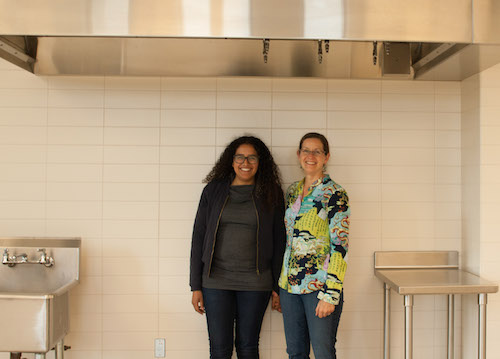
From the wide windows of her Hayes Valley restaurant, Chef Alice Cravens regularly watched high school students walk home as she prepped for evening dinner service. When she first moved in, she had been told that the neighborhood had the highest percentage of low-income youth in San Francisco. But what she didn’t know at the height of her tea-centric restaurant’s popularity, even as San Francisco restaurant critic Michael Bauer praised Modern Tea as “a soothing antidote to our high-tech lives,” is that she would soon cook her way back to high school.
With a pedigree in pastry arts and mentorship under Helen Gustafson, Chez Panisse’s tea buyer from 1997 to 2003, Cravens had established tea programs for the likes of Zuni Café, Delfina and Chez Panisse before opening Modern Tea with her husband. One day, in walked the founder and program director of Community Grows with an idea for Cravens: get kids cooking. Community Grows already nurtured under-served kids to develop and cultivate neighborhood gardens as a means of nutrition and garden education — they wanted to take it farther.

On that first Monday in the spring of 2007 when Modern Tea was closed to the public, Cravens opened the commercial kitchen to kids. As they arrived bearing bouquets of kale and chard, Cravens was quickly hooked. In the cooking classes, they made pasta from scratch. They sautéed kale with garlic. They took what they had grown and picked from the garden and by cooking it, crossed a threshold.
“Seeing their discovery of ‘this is so good’—that whole connection of I-made-it-myself made me want to take Modern Tea and rethink it to open Modern Cooks,” says Cravens.
Modern Cooks was set to provide youth with job experience and training through cooking. Meanwhile, a few blocks away at Ida B. Wells high school, then principal Claudia Anderson had been taking note of Cravens’ impact on community kids. She approached her about bringing culinary arts into the high school as a career technical educator. In 2009, Cravens pivoted from her restaurant kitchen into creating a cooking space in a classroom, morphing Modern Cooks into a high school class she called Heat of the Kitchen.

Ida B. Wells Principal Katie Pringle describes the student body as transient. “All at-risk groups of students are at our school: students in foster care, homeless kids, incarcerated youth,” Cravens says. “Most of my students have had a friend or family member who has been shot and killed. Couple that with the real negative viewpoint of school” and it’s not hard to understand attendance fluctuation. Class attendance for Heat of the Kitchen is 10 percent higher than other classes at Ida B. Wells. Each year 50 to 75 students matriculate through Heat of the Kitchen, some opting to take it a second quarter. Pringle elaborates, “I’ve seen so many students blossom on the baseline level of attendance improving and their grades have improved too.” One Heat of the Kitchen student improved so dramatically, Pringle described it as “night and day” and the student elected to take the class for the full semester. Cravens recognizes her students’ “resilience—they have it but they don’t realize it.” In class the students tap into who they are. “When they realize they have these key attributes of resilience and adaptability inside of them, they can let go and let those attributes shine.”
From the outside, Heat of the Kitchen might look like a high school cooking class, but it’s much more. While the eight-week class is based in the kitchen, it’s a life skills class—one rooted in job readiness, hospitality and communications. The classes teach kids lessons like showing up even on days when they don’t feel like it, conflict resolution, compromise and trust. In class, students have to shed the person they represent outside of class to work on a team.
“Maybe you’re feeling moody about the day. Cheer up and bring that attitude into the work environment and it will impact your day for the better,” says former HOTK student Michael Martinez. “I come in every morning knowing I have to have my head in the game to get a lot of things done. I owe Chef a lot.”
Martinez attended Heat of the Kitchen as a sophomore in 2010. “At the time I was going to school, I would be there and not care what I was doing. Once I enrolled in the class, my attitude started changing.” He credits Cravens, aka “Chef” and Heat of the Kitchen for changing his life. “When she met me, she knew me as a kid who had struggles and family problems. When I got into the class and she saw me enjoying it, she pushed me. I’m out of trouble. I’m not doing what I used to do. I’ve found my peace.” Since graduation, Cravens helped Martinez secure his current prep cook job for a local catering company.
Chef Alex Ong headed San Francisco eatery Betelnut’s kitchen for 12 years as Cravens supplied their tea. He talks about the importance of what Heat of the Kitchen is instilling in students: “Through cooking, teens can learn patience and confidence. Our society is all about instant gratification. If you take a cut of pork that’s tough and braise it, it’s going to take a while and it’s going to be great. The confidence comes in as you take something that is raw and say you’re going to make something amazing out of it. You may fail a few times, but eventually you get to it and develop confidence.” Cravens agrees that in class, sometimes there’s a fear of
making mistakes. But counters it with her no-nonsense optimism, “We’re going to make mistakes. When we fix them together, it’s better.”
In the Heat of the Kitchen, Martinez acknowledges, “I learned a lot of patience working with other people.” Since March, Martinez has volunteered at Heat of the Kitchen as a peer assistant, joining Cravens and HOTK assistant, Debbie Guardado. Every year, the students host a Long Table fundraiser where family and friends dig into a HOTK-cooked dinner.

Ong offers, “What I love about what Alice is doing is something I wish more schools
would do—teach kids how to cook, how to grow their own vegetables, and how to work together.” Six years in, Cravens notes how culinary arts class tie into the rest of the curriculum. “We need to go inside education to make an impact that cooking is as important as English or math. You’re going to need that English and math in the kitchen.” Cravens once teamed up with the economics class to evaluate sushi on “an economic unit of study, costed per piece.”
On the Heat of the Kitchen blog a former student writes, “I have discovered that one
does not have to be born with a skill to make delicious food. It comes from the love you put in the food—and I built friendships with people I thought I’d never talk to.”
From December 2015 to May 2016, Ida B. Wells shuttered for renovations. This fall, students will return to Heat of the Kitchen in their new space: a new kitchen. Cravens is beginning to dream aloud outside school walls to bring her students into the heart of the city. But, some things won’t change. Cravens grounds the class in four truths, framed around the classroom. “Who you are is enough. Do your best work at every step. Own your own potential. Circle back and check in.” And then, without missing a beat, she says, “when in doubt, wash your hands.” These words keep Alice Cravens and her students thriving in the heat of the kitchen.